The NVIDIA GeForce GTX 980 Ti Review
by Ryan Smith on May 31, 2015 6:00 PM ESTOverclocking
Finally, no review of a high-end video card would be complete without a look at overclocking performance.
From a design standpoint, GTX 980 Ti already ships close to its power limits. NVIDIA’s 250W TDP can only be raised another 10% – to 275W – meaning that in TDP limited scenarios there’s not much headroom to play with. On the other hand with the stock voltage being relatively low, in clockspeed limited scenarios there’s still some room for pushing the performance envelope through overvolting. And neither of these options addresses the most potent aspect of overclocking, which is pushing the entire clockspeed curve higher at the same voltages by increasing the clockspeed offsets.
GTX Titan X by comparison ended up being a good overclocker, and while we'd expect GTX 980 Tis to use slightly lower quality chips as part of the binning process, it should still overclock rather well.
| GeForce GTX 980 Ti Overclocking | ||||
| Stock | Overclocked | |||
| Core Clock | 1000MHz | 1250MHz | ||
| Boost Clock | 1075Mhz | 1326MHz | ||
| Max Boost Clock | 1202MHz | 1477MHz | ||
| Memory Clock | 7GHz | 8GHz | ||
| Max Voltage | 1.187v | 1.23v | ||
Overall we're able to get another 250MHz (25%) out of the GTX 980 Ti's GPU, and another 1GHz (14%) out of its VRAM. This pushes the GTX 980 Ti's clockspeeds up to 1326MHz for the standard boost clock, and 1477MHz for the maximum boost clock. The card is heavily TDP limited at this point, so it's unlikely to sustain clockspeeds over 1400MHz, but working clockspeeds in the 1300MHz range are certainly sustainable. Meanwhile interestingly enough, this is actually a slightly better overclock than what we saw with the GTX Titan X; the Titan was only able to get another 200MHz out of its GPU and 800MHz out of its memory. So GTX 980 Ti ends up being the better overclocker by 50MHz.
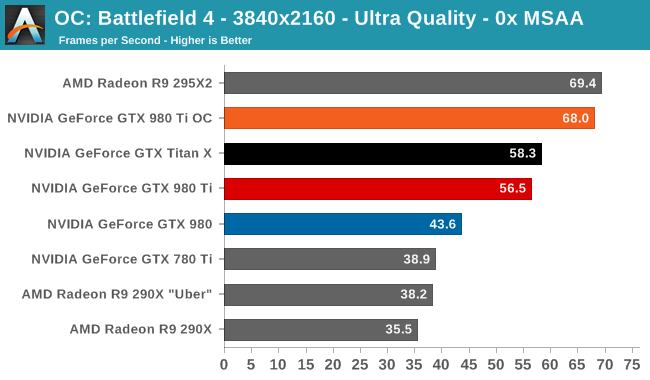
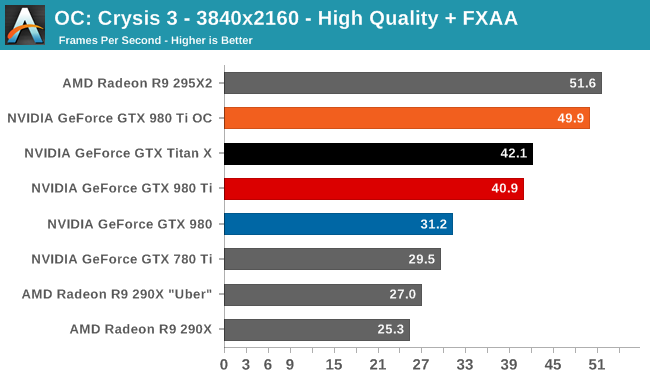
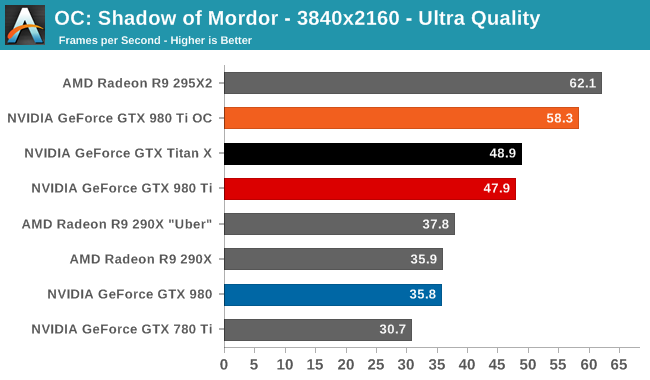
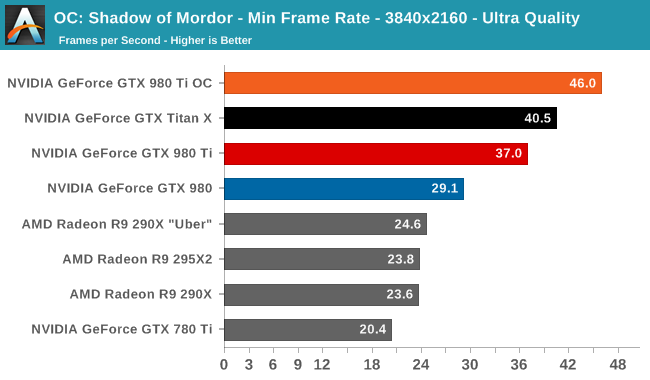
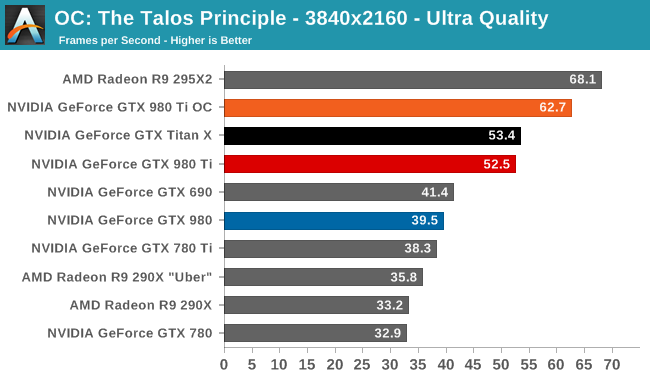
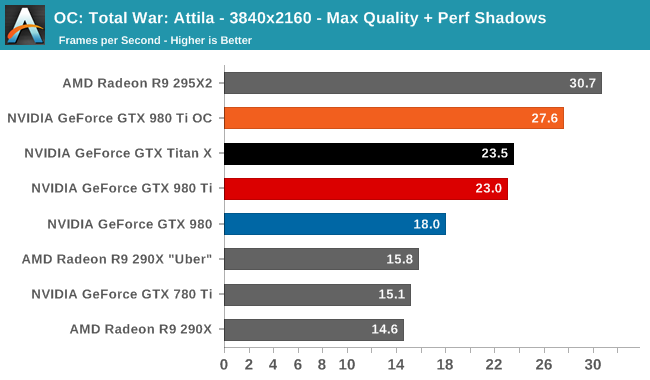
The gains from this overclock are a very consistent across all 5 of our sample games at 4K, with the average performance increase being 20%. Though not quite enough to push the GTX 980 Ti above 60fps in Shadow of Mordor or Crysis 3, it is enough to crack 60fps on Battlefield 4 and The Talos Principle.
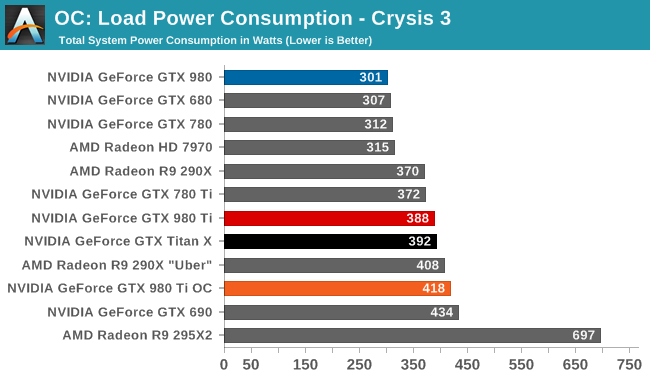
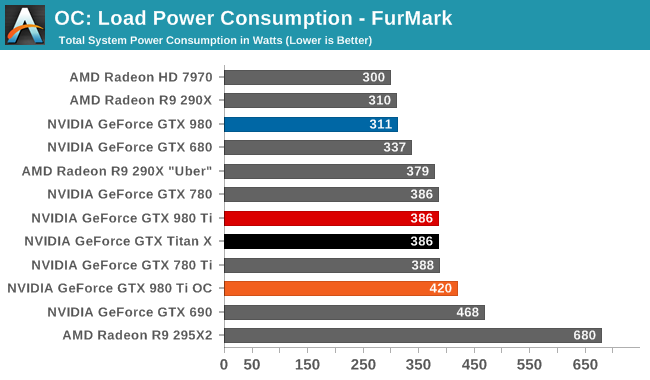
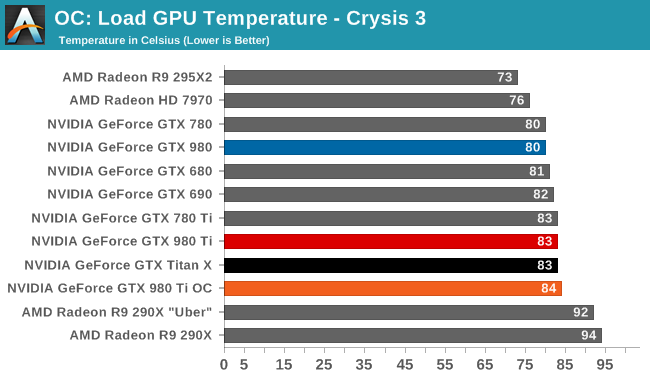
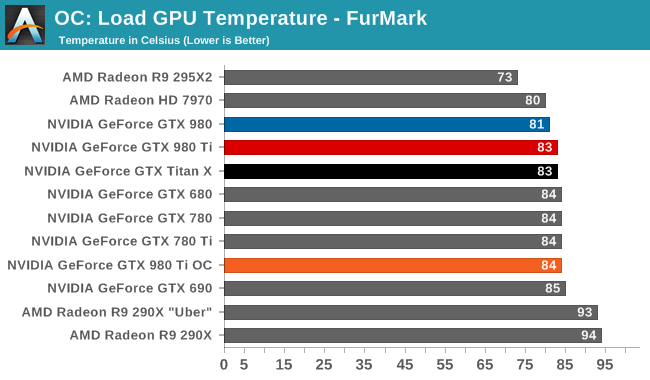
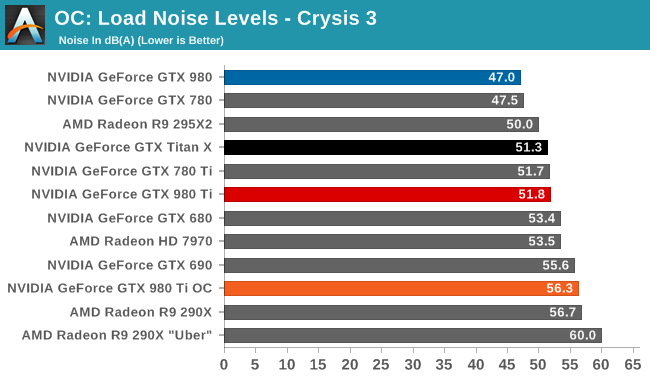
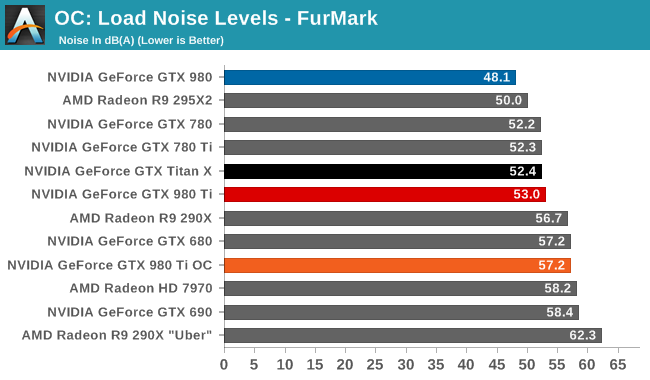
The cost of that 20% overclock in terms of power and noise is similarly straightforward. You're looking at an increased power cost of 30W or so at the wall – in-line with the 25W increase in the card’s TDP – while on the noise front the GTX 980 Ti is pushed out of its sweet spot. Card noise levels will increase by around 4.5dB(A).










290 Comments
View All Comments
xenol - Monday, June 1, 2015 - link
Transistor count means nothing. The GTX 780 Ti has 2.8 billion transistors. The GTX 980 has around 2 billion transistors, and yet the GTX 980 can dance with the GTX 780 Ti in performance.As the saying goes... it's not the size that matters, only how you use it.
Niabureth - Monday, June 1, 2015 - link
Don't want to sound like a messer schmitt but thats 2,8K cuda cores for GK110, and 2K for the GM204. The GK110 has 7.1 billion transistors.jman9295 - Tuesday, June 2, 2015 - link
In this very article they list the transistor count of those two cards in a giant graph. The 980 has 5.2 billion transistors and the 780ti 7.1 billion. Still, your point is the same, they got more performance out of less transistors on the same manufacturing node. All 28nm means is how small the gap is between identical components, in this case the CUDA cores. Each Maxwell CUDA is clearly more efficient than each Kepler. Also helping is the double VRAM size which probably allowed them to also double the ROP count which greatly improved transistor efficiency and performance.Mithan - Sunday, May 31, 2015 - link
It matters because we are close to .16/20nm GPU's, which will destroy these.dragonsqrrl - Sunday, May 31, 2015 - link
"we are close to .16/20nm GPU's"People said the same thing when the 750Ti launched. I'll give give you one thing, we are closer than we were, but we are not "close".
Kevin G - Monday, June 1, 2015 - link
The difference now is that there are actually 20 nm products on the market today, just none of them are GPUs. It seems that without FinFET, 20 nm looks to be optimal only for mobile.felicityc - Tuesday, January 11, 2022 - link
What if I told you we are on 8nm now?LemmingOverlord - Monday, June 1, 2015 - link
@SirMaster - The reason people care about the process node is because that right now - in mid-2015 - this is an extremely mature (ie: old but well-rehearsed) manufacturing process, which has gone through several iterations and can now yield much better results (literally) than the original 28nm process. This means that it's much cheaper to produce because there are less defective parts per wafer (ie: higher yield). Hence ComputerGuy2006 saying what he said.Contrary to what other people say "smaller nm" does NOT imply higher performance. Basically when a shrink comes along you can expect manufacturers to do 1 of two things:
a) higher transistor count in a similar die size, with similar power characteristics when compared to its ancestor - and therefore higher performance
b) same transistor count in a much smaller die size, therefore better thermals/power characteristics
Neither of these factor in architectural enhancements (which sometimes are not that transparent, due to their immaturity).
So ComputerGuy2006 is absolutely right. Nvidia will make a killing on a very mature process which costs them a below-average amount of money to manufacture.
In this case Nvidia is using "defective" Titan X chips to manufacture 980 Ti. Simple as that. Their Titan X leftovers sell for $350 less and you still get almost all the performance a Titan would give you.
royalcrown - Wednesday, June 3, 2015 - link
I take issue with point b) " same transistor count in a much smaller die size, therefore better thermals/power characteristics"I disagree because the same die shrink can also cause a rise in power density, therefore WORSE characteristics (especially thermals).
Gasaraki88 - Monday, June 1, 2015 - link
Smaller nm, bigger e-peen.